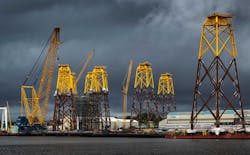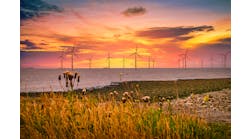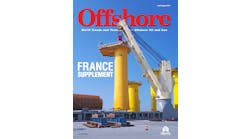Wind farm investments in Europe remain heavily focused on the North Sea, but more projects are starting to emerge off France’s shorelines. Engineering and construction group Eiffage Métal is one of the more active players in both sectors.
The company’s Belgian subsidiary Smulders has an EPCI contract, under a consortium with DEME, to supply 55 jackets for EDPR/ENGIE’s Moray East wind farm off northeast Scotland. All are three-legged structures, 85 m (279 ft) tall, and each weighing 1,000 metric tons (1,102 tons). Most of Eiffage Métal’s factories across Europe have been involved in the production process, including workshops and yards at Balen, Hoboken and Eilhems in Belgium; Lauterborg in France; and Zary in Poland. Fabrication of the consignment has entered the final phase, with the Wallsend yard on the River Tyne in northeast England handling assembly.
According to Arnaud de Villepin, Industrial Division Director at Eiffage Métal, the main challenges have been the scale of the program, due to the large quantity of jackets involved; managing the logistics; the timeframe for delivery; and the industrial approach. Serial production of the jackets is completely different from a conventional offshore platform construction project.
“Some specialist oil and gas fabricators are still entering this market, while others have tried but are now exiting because they have not succeeded. Although still relatively new, offshore wind is a more fiercely contested market than oil and gas because the price of the energy, which has to be competitive. The capex is having to be constantly reduced, because the revenue from wind farms compared with oil and gas - at least until the latest oil price crash - is lower, and government subsidies for these projects are also going down. So, this is not an open market: to compete, you need to have a big yard, a large installation capacity, and a well-developed supply chain.”
Eiffage Métal is also collaborating with DEME on France’s first offshore wind farm, a 480-MW complex located between 12 and 20 km (7.5 and 12 mi) from the port of St. Nazaire on the Guérande peninsula on the west coast. The scope of the EPCI contract, awarded last year, covers the design, fabrication, transportation, and installation of 80 monopiles and transition piece foundations. Construction of the transition pieces is taking place at Smulders’ yard in Antwerp and of the monopiles at SIF in Roermond, the Netherlands. The completed structures will be transported to La Rochelle, south of St. Nazaire, then installed by DEME between spring 2021 and summer 2022.
“The variable seabed soil conditions at the offshore location oblige us to use different installation methods for the monopiles,” de Villepin explained, with a specially-fabricated subsea waves protection device deployed from DEME Offshore’s installation vessel Innovation. “Some of the monopiles can be driven conventionally, while others have to be drilled, or in some cases drilled and driven. The dimensions of the monopiles will be strong enough for each case, this having been taken into account in the engineering phase.”
A floating offshore wind farm market is also starting to emerge in Europe, led by Equinor’s Hywind projects offshore Scotland and in the Norwegian North Sea. Eiffage Métal is the EPCI contractor for a pilot floating wind farm project in the French Mediterranean Sea, which involves assembly of a floater designed by Principle Power Inc.
Assuming contracts are awarded this year as originally planned, Eiffage Métal would fabricate three floater structures between 2021 and 2022. Each would weigh 2,000 metric tons (2,204 tons) and would operate in water depths of up to 70 m (229 ft), over an area of 3.5 sq km (1.35 sq mi). According to de Villepin, PPI’s concept is based on dynamic ballasting. Eiffage Métal would manufacture parts of the columns and bracings, then assemble these at its yard in Fos-sur-Mer. In addition, the company aims to submit bids for other planned conventional and floating wind farms off Le Tréport and Dunkerque in northern France; another close to the island of Noirmoutier off the west coast; and three offshore floating wind farms, one located off the coast of Britanny and the other two in the Mediterranean Sea.
Before the sudden oil price collapse, the company had been monitoring potential oil and gas projects offshore Nigeria suited to its local living-quarter fabrication capability. These included Shell’s shallow-water Block H development and the quarters module for SNEPCO’s deepwater Bonga SW project. Another development of interest was the proposed Phase 2 of BP/Kosmos Energy’s Greater Tortue Ahmeyim project off Mauritania and Senegal. This could involve an extension to the 1.2-km (0.75-mi) long Phase 1 LNG terminal breakwater jetty that Eiffage GC Marine is currently working on, possibly also a living quarter platform. For Phase 1, the company is using a yard in Senegal and the local supply chain to build the jetty’s 25 supporting concrete caissons, each weighing 16,000 metric tons (17,637 tons). The yard, part of a major development at the Port of Dakar, could also be used to bid for future local offshore projects. •




